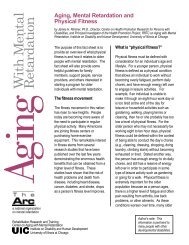Bridging the Aging and Developmental Disabilities Service ... - rrtcadd
Bridging the Aging and Developmental Disabilities Service ... - rrtcadd
Bridging the Aging and Developmental Disabilities Service ... - rrtcadd
You also want an ePaper? Increase the reach of your titles
YUMPU automatically turns print PDFs into web optimized ePapers that Google loves.
• Formal national organizations including <strong>the</strong> American Association on Intellectual <strong>and</strong><br />
<strong>Developmental</strong> <strong>Disabilities</strong>, <strong>the</strong> Gerontological Society of America, <strong>the</strong> Association of<br />
University Centers on <strong>Disabilities</strong> (AUCD), <strong>the</strong> International Association for <strong>the</strong><br />
Scientific Study of Intellectual <strong>Disabilities</strong>, <strong>and</strong> <strong>the</strong> American Society on <strong>Aging</strong><br />
established formal interest groups in aging <strong>and</strong> developmental disabilities.<br />
• The 1986 Wingspread Conference on <strong>Aging</strong> <strong>and</strong> <strong>Developmental</strong> <strong>Disabilities</strong> brought<br />
toge<strong>the</strong>r directors of state DD agencies <strong>and</strong> state units on aging to explore opportunities<br />
for bridging <strong>the</strong> service systems. However, <strong>the</strong> conference did not produce any long-term<br />
results due to <strong>the</strong> (politically linked) high turnover of directors in both agencies. 27<br />
• The 1987 reauthorization of <strong>the</strong> <strong>Developmental</strong> <strong>Disabilities</strong> Act (P.L. 100-146) included<br />
two provisions that recognized <strong>the</strong> aging of adults with developmental disabilities as a<br />
priority. UCEDDs were able to apply for grant supplements to <strong>the</strong>ir core funding to train<br />
personnel in <strong>the</strong> age-related needs of adults with developmental disabilities as one of<br />
three areas of emerging national significance. State developmental disability council<br />
membership was exp<strong>and</strong>ed to include <strong>the</strong> State Unit on <strong>Aging</strong>.<br />
• Several provisions were incorporated in <strong>the</strong> 1987 reauthorization of <strong>the</strong> Older Americans<br />
Act (P.L. 100-175) to foster collaboration between <strong>the</strong> aging <strong>and</strong> developmental<br />
disabilities service systems. Older persons with a severe disability were designated as a<br />
service priority, <strong>and</strong> <strong>the</strong> definition of “severe disability” was identical to <strong>the</strong> functional<br />
definition of developmental disability in <strong>the</strong> 1978 amendments of <strong>the</strong> <strong>Developmental</strong><br />
<strong>Disabilities</strong> Act (P.L. 95-602). The AoA also was authorized to establish a<br />
multidisciplinary gerontology center with special emphasis on disability including people<br />
with severe disabilities. The Commissioner of AoA was authorized to consult with <strong>the</strong><br />
Commissioner of ADD on <strong>the</strong> administration of <strong>the</strong> DD Act <strong>and</strong> <strong>the</strong> Older Americans Act<br />
with an emphasis on community-based alternatives to long-term care. State <strong>and</strong> area<br />
agency on aging plans were to include older people with severe disabilities as a service<br />
priority. The state unit on aging long-term care ombudsman program was required to<br />
coordinate ombudsman services with <strong>the</strong> Protection <strong>and</strong> Advocacy agency for people<br />
with developmental disabilities. Disabled dependent adults under <strong>the</strong> age of 60 were<br />
allowed to be served at nutrition site programs when accompanied by an eligible older<br />
caregiver.<br />
• In 1988 <strong>the</strong> Health Care Financing Administration (HCFA) (now CMS) included an<br />
Active Treatment objective to minimize skill regression due to aging.<br />
• The 1992 Amendments to <strong>the</strong> Older Americans Act targeted outreach to older parents<br />
caring for an adult son or daughter with developmental disabilities at home <strong>and</strong><br />
authorized Title IV funding for training <strong>and</strong> demonstration projects to address <strong>the</strong> needs<br />
of older adults with developmental disabilities <strong>and</strong> older family caregivers.<br />
• In 1989 ADD <strong>and</strong> AoA executed a Memor<strong>and</strong>um of Agreement 28 (Appendix 3) to<br />
discuss <strong>and</strong> develop joint initiatives to improve <strong>the</strong> coordination of <strong>the</strong>ir programs <strong>and</strong><br />
<strong>Bridging</strong> <strong>the</strong> <strong>Aging</strong> <strong>and</strong> <strong>Developmental</strong> <strong>Disabilities</strong> <strong>Service</strong> Networks Page 20



